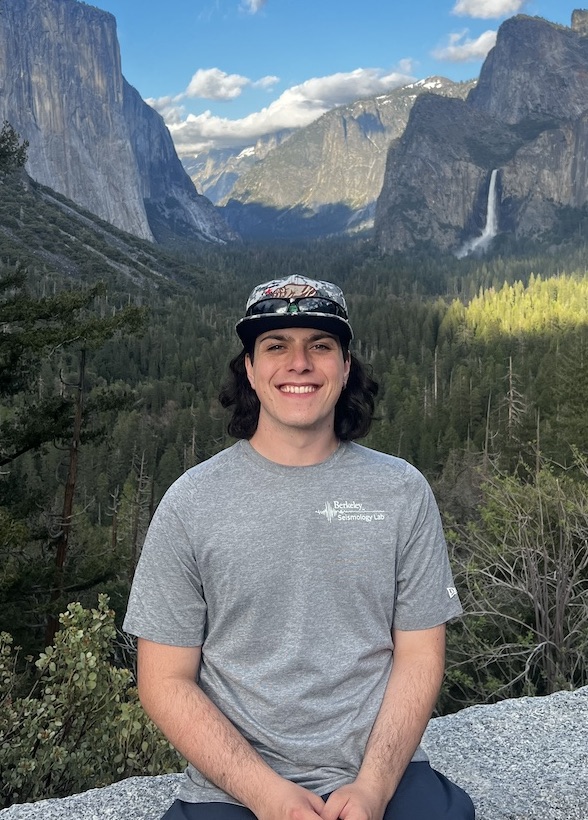Undergraduate Researcher
I am a current undergraduate senior pursuing a double major in geophysics and astrophysics at UC Berkeley. My research focuses on measuring azimuthal anisotropy in the southwest Pacific using both source-side and station-side measurements, integrating observational and theoretical seismology. The results of this work will serve as constraints for the full-waveform tomography of the southwest Pacific, which is being developed within the Global Seismology Research Group.
As I approach graduation, I am actively seeking opportunities to advance my expertise, either through graduate programs or full-time employment. I am particularly interested in applying my skills to better understand the interior structure of the Earth and other terrestrial planets, with the goal of contributing to our knowledge of planetary structure and evolution.
Please feel free to explore my work below or contact me via email for further inquiries.
Constraining Source and Station Side Azimuthal Anisotropy in the Southwest Pacific Using Shear Wave Splitting Measurements (AGU 2024)
The presence of seismic anisotropy in the upper mantle is well-known and attributed to the alignment of olivine crystals from past and/or present mantle flow. Constraining it is important for improving our understanding of the formation and evolution of the lithosphere-asthenosphere system and deeper mantle flow around subducted slabs. This study focuses on developing a reliable catalog of azimuthal anisotropy measurements for the southwest Pacific using a combination of station-side and source-side anisotropy methodologies. Effective methods utilizing shear wave splitting of SKS phases to measure station side azimuthal anisotropy have been developed, assuming good azimuthal coverage of sources. However, when applied to the southwest Pacific, our past results from station-side anisotropy analysis indicate poor azimuthal coverage for SKS phases and complex anisotropic structure, compounded by a lack of long-enough broadband recordings to perform robust measurements. These challenges necessitate the usage of alternative methods, such as splitting measurements of S waves from deep earthquakes at shorter distances and measurements of source-side anisotropy to complement our current methodology. While these methods are harder to implement, they are suitable for the southwest Pacific, where the frequent seismicity from numerous subduction zones provides complementary sampling of the upper mantle in the region. Additional waveforms and their associated methods will be incorporated into our current measurement process, enabling us to achieve a more comprehensive anisotropic model of the region. Results from these refined measurements will be contributed as constraints for the full waveform azimuthal anisotropy tomography of the southwest Pacific upper mantle and transition zone.
Investigating Antarctic Ice Sheet Properties Using Ps Receiver Functions (AGU 2024)
In this study, we used seismic waves, specifically Ps receiver functions, to measure the thickness and internal properties of the Antarctic Ice Sheet. Ice mass changes in the Antarctic Ice Sheet happen on wide-ranging time scales. Understanding these variations is crucial due to their implications for changes in global sea level. While many types of geophysical data provide information on ice sheet properties, Ps waves and their reverberations recorded by Antarctic stations can constrain ice sheet structure over lateral length scales of a few kilometers local to the station, in some cases continuously over the last two decades. Synthetic Ps receiver functions, calculated for a range of ice sheet structural models, demonstrate that trade-offs exist between ice thickness, average ice Vs and Vp, and internal layering. At relatively high frequencies (e.g., waveforms filtered at 0.3-4.0 Hz), Ps receiver functions can resolve changes in ice thickness of ~200 m and velocity variations of ~5%. In addition, the presence of thin low-velocity layers at the base of the ice sheet, for example, due to liquid water or water-rich sediments, significantly impact Ps receiver function phases. Data from several broadband stations on the Antarctic Ice Sheet show remarkably clear Ps conversions from the base of the ice and their first reverberation (Ppps). At some stations, differences in Ps receiver functions stacked in back-azimuthal bins reveal lateral heterogeneities in local ice sheet structure. For stations that have been operating for decades, we are in the process of investigating whether statistically robust secular variations are present within the receiver function phases. This approach to measuring ice sheet properties has the potential to yield new constraints on changes in ice mass over decadal time scales.
Refining Splitting Intensity Measurements of Shear Wave Splitting for Multi-Layer Anisotropy (SSA 2024)
The presence of seismic anisotropy within the Earth’s upper mantle is wellknown and observed. Methods for measuring azimuthal anisotropy through shear wave splitting (Silver & Chan 1991, Vinnik et al. 1989) are proven to be effective, assuming a single layer of anisotropy with horizontal symmetry. However, these methods become less reliable when applied to regions of the Earth with more than one anisotropic layer. Results from these methods in the southwest Pacific imply non-orthogonal polarization directions, indicative of multi-layer anisotropy. The mentioned methodologies can produce multilayer anisotropy measurements, but the resolution is highly dependent on azimuthal coverage and seismic data quality. Splitting Intensity (SI) is a robust method to measure azimuthal anisotropy from lower-quality data (Chevrot 2000), but it is mainly applied to single layer anisotropy. Based on previously published theoretical expressions (Romanowicz & Yuan 2011), SI can be calculated from multiple layers of anisotropy.
The focus of this study is to develop a robust measurement process for shear wave splitting in complex anisotropic media, incorporating the multi-layer expression of SI to solve for station-average anisotropic measurements. A double grid search method is applied to obtain splitting parameters from seismic data. Preliminary results of SI from stations inferred to have multi-layer anisotropy correlate with results presented with the theoretical expressions. Further development is required to refine the SI results obtained from this continually improving method. Results from this finer-constrained measurement process will be contributed as constraints for azimuthal anisotropy full waveform tomography of the southwest Pacific upper mantle and transition zone.
